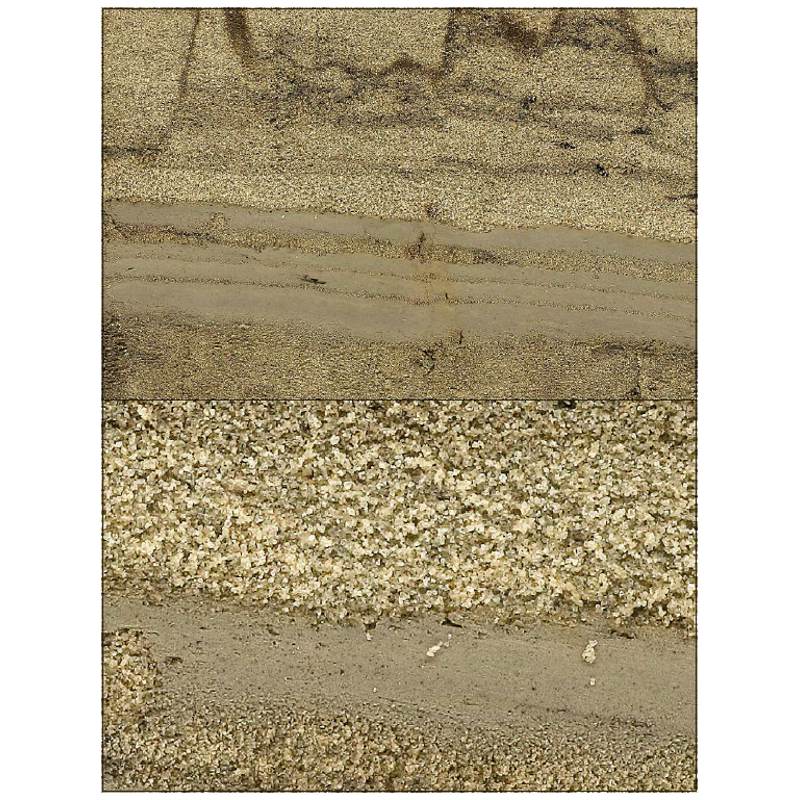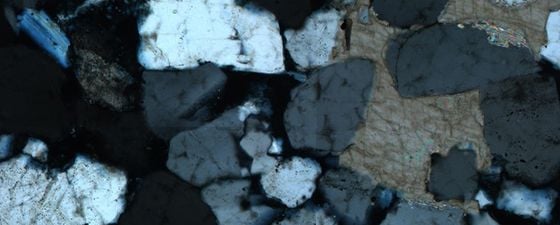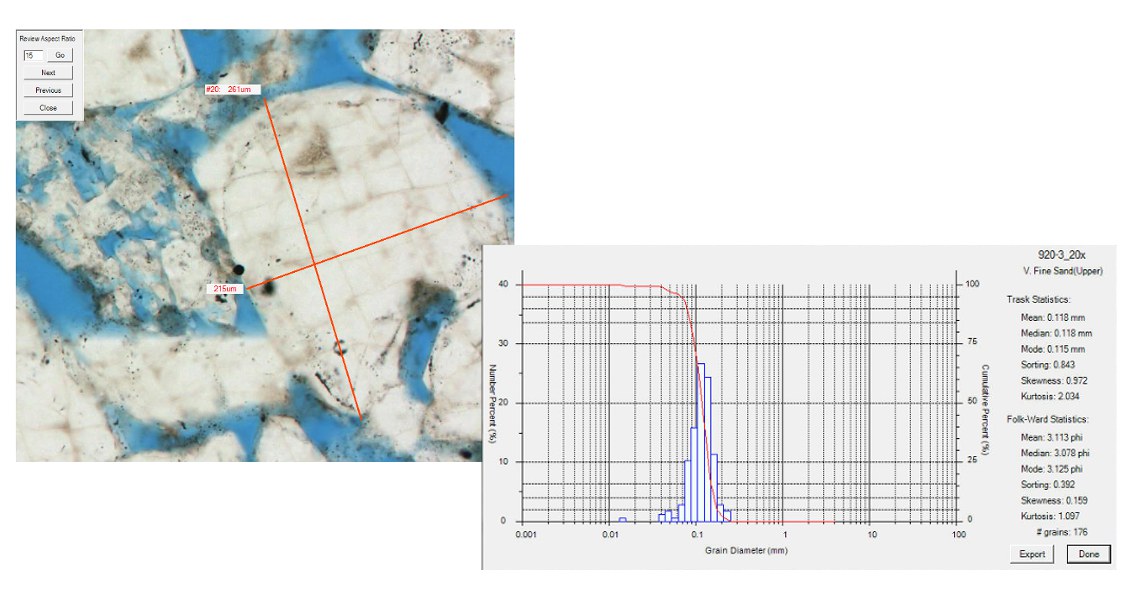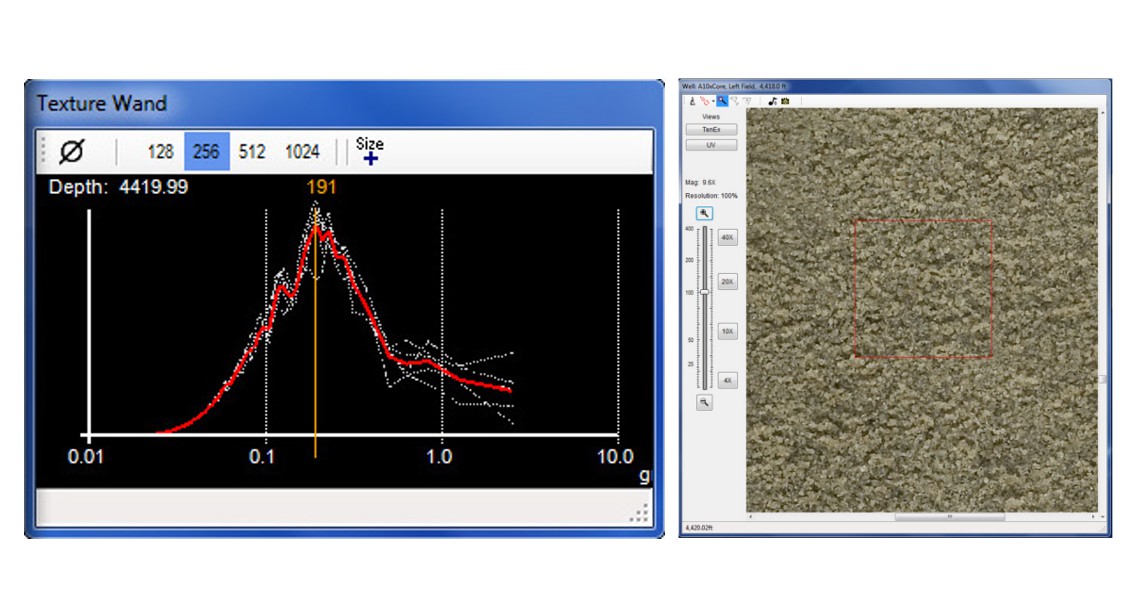The keys to the efficacy and value of cores in the oil and gas industry are accessibility and facility. Core description has always been done in lay-out rooms – and those lay-out rooms have always been travel destinations, no matter if they are halfway across town or halfway around the world. Once there, a geologist or two can evaluate the core using the tools they have always used: a 10x hand lens, a sand card, a ruler, protractor, a bottle of dilute hydrochloric acid, and a pad of paper. In most cases they will be the only people to examine the core and the only ones with the opportunity to do so. This limits the timely interchange of ideas vital within today’s oil and gas industry.
Advantages of the Digital Archive
 Standard 300 dpi ‘high-resolution’ imagery (top) compared to the 1,360 dpi resolution available using the TenEx imagery system (bottom).A digital archive of core imagery enables everyone to read from the same page no matter if they are in Williston, Denver, Luanda or London. When that core is imaged at the resolution of a 10x hand lens (or higher) it affords the opportunity for more scientists from all the interested working groups to evaluate it simultaneously. As more information arrives in the form of routine core analysis, well logs, thin sections, SCAL or written evaluations, a digital core archive must be able to accommodate the new information and make that accessible as well. This allows all of the interested parties to examine the core in the context of petrophysical response, and to examine laboratory results for their repeatability. More importantly, it permits the corporation or public organisation to centralise the data in order to forestall the inevitable ‘data hunt’ that accompanies any re-evaluation of the well.
Standard 300 dpi ‘high-resolution’ imagery (top) compared to the 1,360 dpi resolution available using the TenEx imagery system (bottom).A digital archive of core imagery enables everyone to read from the same page no matter if they are in Williston, Denver, Luanda or London. When that core is imaged at the resolution of a 10x hand lens (or higher) it affords the opportunity for more scientists from all the interested working groups to evaluate it simultaneously. As more information arrives in the form of routine core analysis, well logs, thin sections, SCAL or written evaluations, a digital core archive must be able to accommodate the new information and make that accessible as well. This allows all of the interested parties to examine the core in the context of petrophysical response, and to examine laboratory results for their repeatability. More importantly, it permits the corporation or public organisation to centralise the data in order to forestall the inevitable ‘data hunt’ that accompanies any re-evaluation of the well.
Finally, there is facility. A digital core archive must enable the user to interact with the imagery to extract useful information. Most core is imaged, but the imagery is static; it is good for looking, but not good for doing. A high-resolution digital archiving system must contain tools for interacting with the imagery. These include methods for determining grain size, apparent dip, net pay, mineralic composition, colour and optical porosity, as well as tools for comparing the core with the logs.
PetroArc International, based in Houston, provides high-resolution imagery for the oil and gas business and believes it has found new ways to refine and centralise digital information, making it available wherever in the world it is needed. Using its TenEx imagery system, core is digitised at the resolution of a 10x hand lens (or higher). The thin section ‘MicroPics’ can be imaged up to 1,000x magnification, the equivalent of a 100x objective lens. The company can also provide imagery of core plugs and cuttings, as well as biological samples for the medical profession.
This is not just simply taking digital photos of cores laid out on a bench! First, the cores are sanded and polished to a finish where all saw marks, roughness, dust and other obscuring matter are removed, allowing easy viewing of grains, fossils and porosity with the naked eye. This can take many hours or even weeks, depending on the composition of the core. Then a PetroArc digital imaging specialist scans the core, creating high resolution, depth-registered digital images which provide an easy-to-store visual record of the core that will not degrade over time and are easily duplicated and shared.
Virtual Microscope
But this is only half the story. Most imagery is static; one can look at it, but that is all. To counter this, PetroArc International has developed virtual microscope technology which can interact with the imagery to perform analytical tasks, an example of which is a virtual petrographic microscope for thin sections. With this, the user can navigate throughout the slide, cross the polarisers, perform grain size, aspect ratio and mineralogy point counts, and review them at any time.
The company has also designed software (CORSystem) which allows the user to examine the core, logs, lab reports and data, as well as analytical reports at the same time. At its centre is a virtual core microscope with tools to examine the core, measure apparent dip, as well as record the presence of index fossils, formation boundaries and a variety of other characteristics.
CORSystem also contains innovative new tools for estimating grain size and cm-scale heterogeneity. All of the information is available to all the users, no matter where they are in the world.
A high resolution digital core archive must be designed in such a way that the data is easily accessible, even data that arrives months or years after the core is imaged. It must also allow the users to perform routine analytical tasks from their desktops using the tools that are commonly used for evaluation. Such an archive has the potential to revolutionise the manner in which core is handled and evaluated, but only if the information is easily accessible and the access system has the facility for the users to get their work done.









